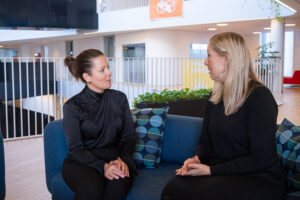Nordic cities strengthen their work for age-friendly cities
Older adults
28 Nov 2023
Building age-friendly cities and communities can reduce public spending on healthcare and social care, while making use of the resource that older adults represent in our communities. Today, twelve Nordic cities are part of the WHO Global Network for Age-friendly Cities and Communities. The Nordic cities in the network actively share their best practices of how to create cities that are economically, socially, and culturally inclusive for an ageing population.
– When we talk about ageing and older adults, we almost exclusively discuss healthcare, when it’s about healthy ageing. Strengthening the quality of life, health, and well-being among the older population benefits everyone in society, says Emma Matsson, Developing Manager for Agefriendly Gothenburg.
If you create more inclusive housing models with more shared spaces for social living, a more flexible public transportation system, and outdoor areas with more seating and activities, it benefits everyone.
– In many Norwegian municipalities, soon 40 per cent of the population will be above 70 years of age. At that point, we need to have considered their input on how they want things to be, so they can ‘age in place’, says Anne Berit Rafoss, Project Manager at the Centre for an Age-Friendly Norway.
Learning from each other
Matsson and Rafoss were two of the participants at the conference Age-friendly cities in the Nordic region, that took place in Copenhagen on 2-3 November. The conference was organized by the Nordic Welfare Centre and the World Health Organization (WHO), gathering municipalities, researchers, and experts. The focus was sharing best practices and tips between the Nordic countries, and it showed that a lot of efforts are already being made.

Examples from Gothenburg, Sweden, include the “chatty benches”. The yellow benches are installed all over the city in spots that seniors have defined as favourites. Labelled with the text Feel free to sit here if you find it nice to talk with someone, they encourage intergenerational conversations. Next year, the first World Masters Athletics Championship will be held in Gothenburg, encouraging physical activity, and creating new friendships. And the senior network Future developers has, since 2019, been collaborating with the City of Gothenburg to make the city more age-friendly, participating in urban development projects.
In Turku, Finland, strength- and balance training for people aged 75 and older have resulted in that 77 per cent of the participants feel a better ability to function in everyday life. Another ageing-friendly measure is a virtual concert-tour by the philharmonic city orchestra, visiting assisted living units and the premises of housing service units and associations.
Events bringing people together
In Norway, the Generation Games, arranged for the first time in Oslo in 2017, have become a success. This year, 37 municipalities arranged their own games – a free event bringing people of all ages together for physical activities, games, and fun. The games are arranged by municipalities together with volunteers, associations, clubs, organizations, and local businesses. From 2024, Generation Games is part of a new national reform for older adults.
The Walker Race started in Norway, but found its way to Uppsala, Sweden this year. This competition is not about pace – the best decorated walker wins. Another example from Uppsala is the senior lunches in school, where older adults can come and have lunch at schools, simultaneously bringing different generations closer together.
Today, there are over 1,500 communities in 51 countries who are members of the WHO Global Network for Age-friendly Cities and Communities. In the Nordic region, there are 12 member-cities: Oslo, Trondheim, Esbjerg, Gothenburg, Uppsala, Hallstahammar, Stockholm, Gävle, Östersund, Tampere, Turku and Reykjavik. Another member in addition to this is the Centre for an Age-Friendly Norway (Senteret for et aldersvennlig Norge).
Changing the narrative
Working towards age-friendly environments includes changing the narrative about the ageing population, so they are no longer spoken about as a burden, cost, and challenge, but rather to highlight the enormous potential they bring to our communities.
– If older individuals are given better opportunities to maintain their health, be active, and participate in the community, they also become a support for the younger generation. I encounter older adults in my daily work who want to be a part of the city’s development through, for example, solving social integration issues, mentorship programs, or by supporting single mothers. Among other things, they have time to listen – a scarce resource today, says Emma Matsson.
In the last ten years, we have become better at involving older adults in the development of age-friendly cities and communities, says Anne Berit Rafoss. The focus has shifted from doing something for older people to doing something with them.
– We get a lot of engagement among older adults. The challenge now is to increase cross-sectoral collaboration and get all sectors on board.
Text and photo: Heidi Hakala
Related news
Welfare policy
10 Jan 2023
